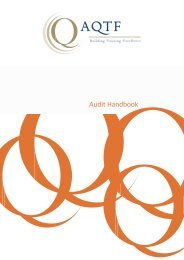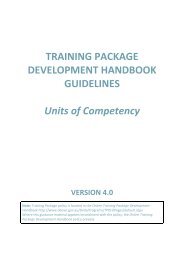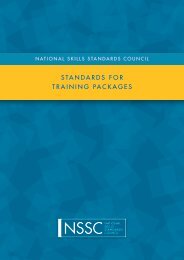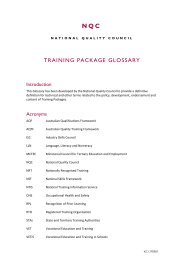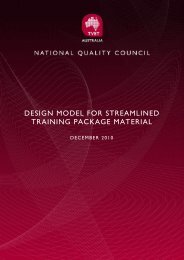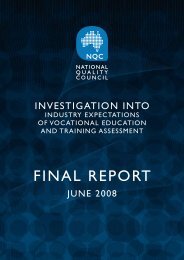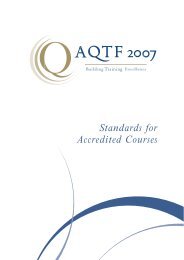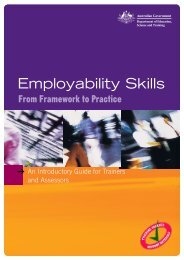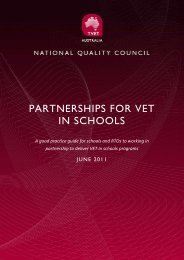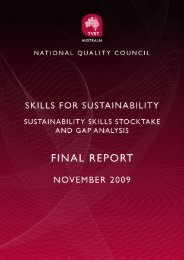VET Products for the 21st Century - National Skills Standards Council
VET Products for the 21st Century - National Skills Standards Council
VET Products for the 21st Century - National Skills Standards Council
Create successful ePaper yourself
Turn your PDF publications into a flip-book with our unique Google optimized e-Paper software.
5 . 2 Q u a l i f i c a t i o n sThe consultations revealed overwhelming support<strong>for</strong> retaining Training Packages and AccreditedCourses as <strong>the</strong> single organising framework <strong>for</strong>qualifications in <strong>the</strong> <strong>VET</strong> system. There was,however, a desire <strong>for</strong> packaging rules to beharmonised as much as possible and to allow <strong>for</strong><strong>the</strong> widest choice of elective units from within andacross Packages and from accredited courseswhere appropriate. There is a strong commitmentto allowing enough flexibility in qualificationstructures to ensure that one single industrydefinedsystem meets all needs. The differingnature of industries, from traditional trades (oftenhighly regulated) to newer or unregulated industriesin which <strong>the</strong> requirements are more difficult todefine, was also recognised, but it was felt <strong>the</strong>sedifferent needs should be addressed within a singlecohesive system. There is also support <strong>for</strong>ensuring a stronger focus on preparatory andenabling qualifications aimed at building generalwork<strong>for</strong>ce capability and entry to a range of jobs inindustry and occupational areas. This could beachieved by explicitly incorporating suchqualifications into <strong>the</strong> national framework in a moresystematic way.Consultations with industry groups and withproviders also highlighted <strong>the</strong> importance ofunderpinning knowledge or <strong>the</strong>ory in <strong>the</strong>development of competence, noting that this isespecially true <strong>for</strong> qualifications which require highlevels of knowledge and <strong>the</strong>ory to underpincompetency. Many of those consulted believed that<strong>the</strong> knowledge components of units of competencydo not receive enough attention in training. Thekey issue appears to be <strong>the</strong> extent to which <strong>the</strong>knowledge requirements are made explicit inTraining Packages. While some Training Packagesexpress <strong>the</strong> knowledge component effectively at<strong>the</strong> unit level, o<strong>the</strong>rs do not identify it as clearly.Consultations did not address whe<strong>the</strong>r <strong>the</strong>knowledge components are comprehensive andsufficiently <strong>for</strong>ward-looking and this will requirefur<strong>the</strong>r investigation during <strong>the</strong> design anddevelopment phase. There is overwhelmingsupport however, <strong>for</strong> knowledge to be presentedclearly and in a <strong>for</strong>m within <strong>the</strong> unit and/orqualification that its importance is recognised byRTOs, funders and o<strong>the</strong>r stakeholders.RecommendationsThat <strong>the</strong> NQC:5. Reaffirm a single organising framework <strong>for</strong> <strong>VET</strong> qualifications comprised of Training Packages andAccredited Courses and allow <strong>for</strong> qualifications that achieve or contribute to occupational outcomes orfoundation skills [i.e., Language, Literacy and Numeracy (LLN) and general education].6. In order to maximise consistency, flexibility and responsiveness, undertake a full and comprehensivereview of:• packaging rules as applied in Training Packages to ensure maximum flexibility and consistency withinand across Training Packages and Accredited Courses, where both possible and appropriate;• <strong>the</strong> use of units from accredited courses within Training Packages; and• <strong>the</strong> process <strong>for</strong> developing and approving Accredited Courses including:- how duplication of training package content and coverage is identified and resolved;- improving consistency between state accrediting bodies and across <strong>the</strong> ISCs.The report on <strong>the</strong> outcomes to go to <strong>the</strong> September COAG meeting and include detailed changes to beimplemented by <strong>the</strong> NQC as a matter of urgency. 107. Ensure that units of competency are efficiently utilised within and across industry in order to avoidduplication wherever possible.8. Ensure a stronger focus on preparatory and enabling qualifications aimed at building general work<strong>for</strong>cecapability and entry to a range of jobs in industry and occupational areas by explicitly incorporating suchqualifications into <strong>the</strong> national framework in a more systematic way.9. Ensure that Certificates I and II are clearly identified as ei<strong>the</strong>r preparatory or entry-level qualifications.10. Allow <strong>VET</strong> qualifications to provide <strong>for</strong> identified knowledge and preparatory units of competency asappropriate.10Refer to page 9 <strong>for</strong> additional resolution from MCVTE<strong>VET</strong> PRODUCTS FOR THE 21 ST CENTURY - 15



